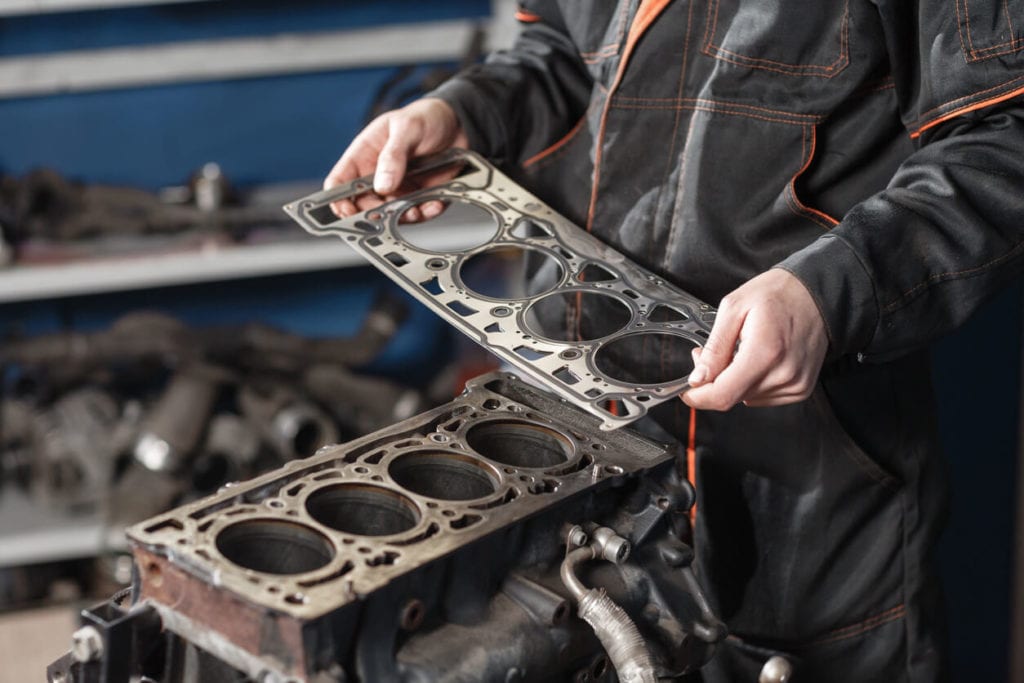 Located between the cylinder head and the engine block, you’ll find the head gasket. This small yet vital component is used to seal the internal combustion process allowing coolant and oil to travel throughout the engine to cool and lubricate. Which means, when it “blows,” it could spell big trouble for the engine. Blown head gasket symptoms are pretty easy to identify and need to be rectified pretty quickly to prevent damage to your engine. This article will help you understand the head gasket, what it does, and how to know when it fails.
Located between the cylinder head and the engine block, you’ll find the head gasket. This small yet vital component is used to seal the internal combustion process allowing coolant and oil to travel throughout the engine to cool and lubricate. Which means, when it “blows,” it could spell big trouble for the engine. Blown head gasket symptoms are pretty easy to identify and need to be rectified pretty quickly to prevent damage to your engine. This article will help you understand the head gasket, what it does, and how to know when it fails.
What is a Head Gasket?
In addition to sealing the combustion portion of the engine to allow oil and coolant to circulate, the head gasket also seals the combustion chamber in the engine. This allows the vehicle to produce enough power to move forward, as well as keep harmful gases from exiting the combustion chamber by directing them through the exhaust system. The head gasket in modern vehicles is comprised of several layers of steel material entwined with elastomer, making them more durable and longer lasting. Vehicles produced in the past were equipped with gaskets created by graphite or asbestos. In comparison, today’s gaskets are better as they are less prone to leakage and have little to no health risks as opposed to asbestos produced gaskets.
The head gasket is a vital component within the combustible engine. The head gasket ensures the pressure created from the spark plug’s ignition of fuel vapors remains within the combustion chamber. The combustion chamber contains the pistons and needs a high amount of pressure to ensure the pistons continue to fire appropriately. Additionally, oil and coolant have equally important jobs but, in order to perform their tasks efficiently, they cannot mix. The head gasket keeps the chambers separated to ensure there is no cross-contamination of fluids.
What Causes a Head Gasket to Blow?
The most common cause of a blown, or damaged, the head gasket is often a result of an engine that has gotten too hot. High engine temperatures are usually caused by a lack of coolant within the radiator, usually due to a leak. Some gaskets are likely to weaken sooner than others depending on their material. Aluminum, for example, expands faster when heated. Metals that have a higher thermal expansion rate are more sensitive to heat. Higher temperatures can cause the object to change shape, producing an unfavorable outcome. Expansion and distortion of the cylinder head as a result of heat weakens its integrity preventing the head gasket from sealing properly.
When the head gasket has blown, it’s critical that it be addressed immediately. Continuing to operate a vehicle with a blown gasket can cause serious and irreparable damage to the engine. As the gasket is used as a seal, maintaining pressure is the key to engine power. Once the gasket blows, it is no longer able to act as a seal and will allow pressure to escape, significantly reducing the engine’s power, one of the few signs of a blown head gasket. Additionally, oil and coolant passageways may begin to leak into areas where they shouldn’t be. When coolant enters the combustion chambers, it mixes and dilutes the engine oil, while also decreasing the cooling capabilities of the cooling system, which may cause engine overheating.
Blown Head Gasket Symptoms
The engine relies on three vital fluids in order to run: fuel, coolant, and motor oil. If the gasket blows, all fluids may enter into or out of the combustion chamber. You may notice a few or all of the following:
- Overheating – Caused by a lack of or reduced coolant. Also caused by hydrocarbons entering the cooling system.
- White, Blue, or Grey smoke – Indicates coolant or oil has entered the combustion chamber.
- Loss of Power – Due to a lack of compression resulting in sputtering, loss of power, and reduced fuel efficiency.
- Discolored Oil – A chocolate milk-looking oil is indicative of coolant mixing with oil in the engine.
Get Help
Extensive damage to the engine as a result of a blown head gasket is the most unfavorable kind of engine problem. A busted head gasket that is ignored may require repair of the engine block, cylinder heads, or a complete engine replacement. If you notice any of the symptoms that may indicate your vehicle has blown a head gasket, don’t wait to have an inspection. Sun Auto Service’s expert Technicians have the knowledge and experience to help repair your engine. Not comfortable driving your vehicle for fear of risking additional damage to the engine? We’ll come to you! We offer complimentary towing with most major repairs. When you need repairs and you need them fast, reach out to a Sun Auto Service near you. We’re here to help!
